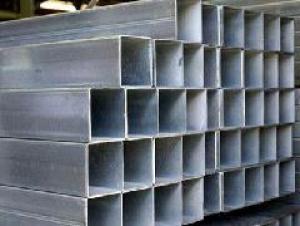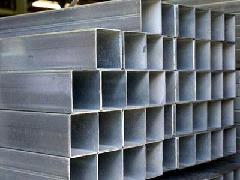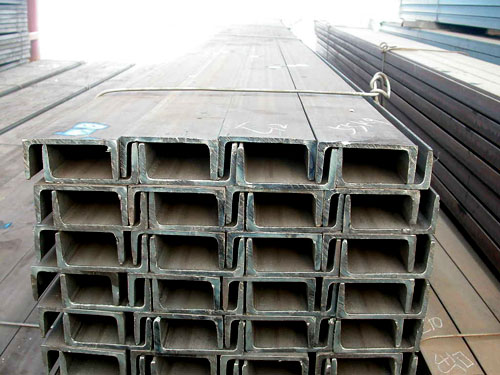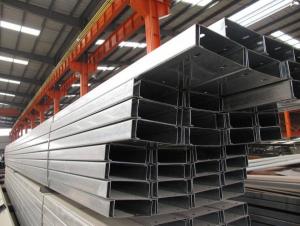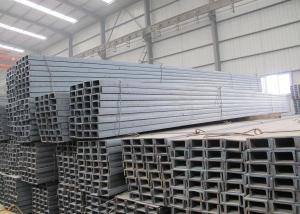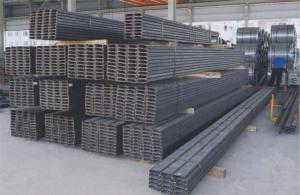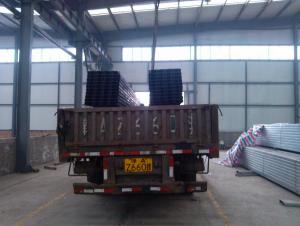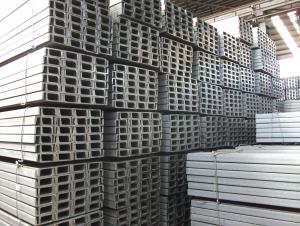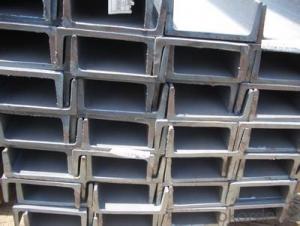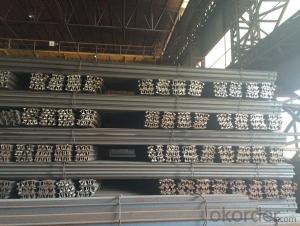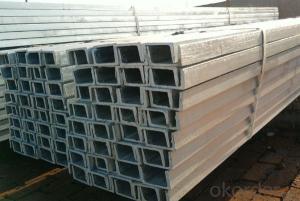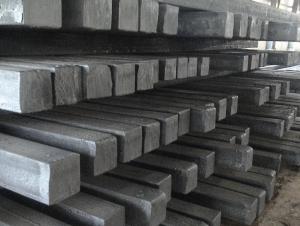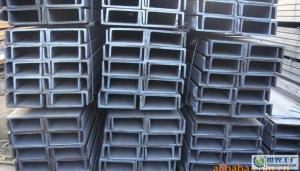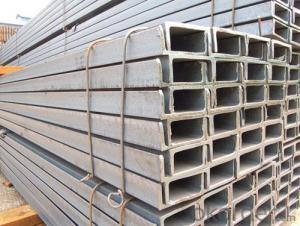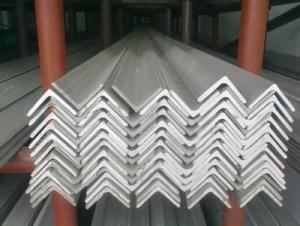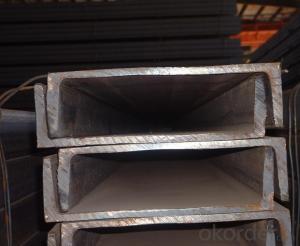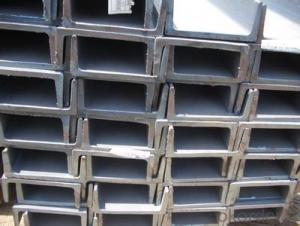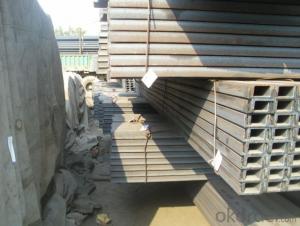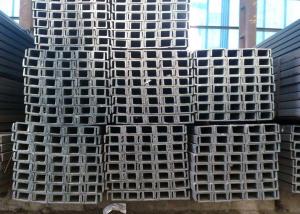UPN JIS U Channel JIS SS400 or GB Q235 Q345B for all Sizes
- Loading Port:
- China Main Port
- Payment Terms:
- TT or LC
- Min Order Qty:
- -
- Supply Capability:
- -
OKorder Service Pledge
OKorder Financial Service
You Might Also Like
Product Description:
OKorder is offering high quality UPN JIS U Channel JIS SS400 or GB Q235 Q345B for all Sizesat great prices with worldwide shipping. Our supplier is a world-class manufacturer of steel, with our products utilized the world over. OKorder annually supplies products to European, North American and Asian markets. We provide quotations within 24 hours of receiving an inquiry and guarantee competitive prices.
Product Applications:
According to the needs of different structures, Angle can compose to different force support component, and also can be the connections between components. It is widely used in various building structures and engineering structures such as roof beams, bridges, transmission towers, hoisting machinery and transport machinery, ships, industrial furnaces, reaction tower, container frame and warehouse etc
Product Advantages:
OKorder's UPN JIS U Channel JIS SS400 or GB Q235 Q345B for all Sizes are durable, strong, and resist corrosion.
Main Product Features:
· Premium quality
· Prompt delivery & seaworthy packing (30 days after receiving deposit)
· Corrosion resistance
· Can be recycled and reused
· Mill test certification
· Professional Service
· Competitive pricing
Product Specifications:
Manufacture: Hot rolled
Grade: Q195 – 235
Certificates: ISO, SGS, BV, CIQ
Length: 6m – 12m, as per customer request
Packaging: Export packing, nude packing, bundled
Sizes: 25mm-250mm | ||||||||||||
a*t | ||||||||||||
25*2.5-4.0 | 70*6.0-9.0 | 130*9.0-15 | ||||||||||
30*2.5-6.6 | 75*6.0-9.0 | 140*10-14 | ||||||||||
36*3.0-5.0 | 80*5.0-10 | 150*10-20 | ||||||||||
38*2.3-6.0 | 90*7.0-10 | 160*10-16 | ||||||||||
40*3.0-5.0 | 100*6.0-12 | 175*12-15 | ||||||||||
45*4.0-6.0 | 110*8.0-10 | 180*12-18 | ||||||||||
50*4.0-6.0 | 120*6.0-15 | 200*14-25 | ||||||||||
60*4.0-8.0 | 125*8.0-14 | 250*25 | ||||||||||
FAQ:
Q1: How do we guarantee the quality of our products?
A1: We have established an advanced quality management system which conducts strict quality tests at every step, from raw materials to the final product. At the same time, we provide extensive follow-up service assurances as required.
Q2: What makes stainless steel stainless?
A2: Stainless steel must contain at least 10.5 % chromium. It is this element that reacts with the oxygen in the air to form a complex chrome-oxide surface layer that is invisible but strong enough to prevent further oxygen from "staining" (rusting) the surface. Higher levels of chromium and the addition of other alloying elements such as nickel and molybdenum enhance this surface layer and improve the corrosion resistance of the stainless material.
Q3: Can stainless steel rust?
A3: Stainless does not "rust" as you think of regular steel rusting with a red oxide on the surface that flakes off. If you see red rust it is probably due to some iron particles that have contaminated the surface of the stainless steel and it is these iron particles that are rusting. Look at the source of the rusting and see if you can remove it from the surface.
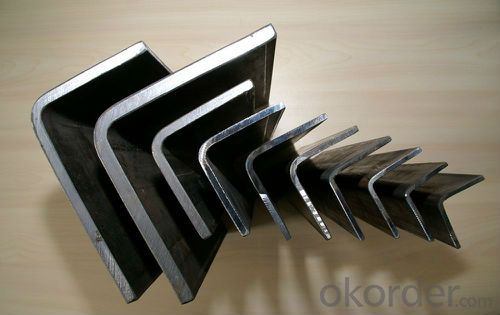
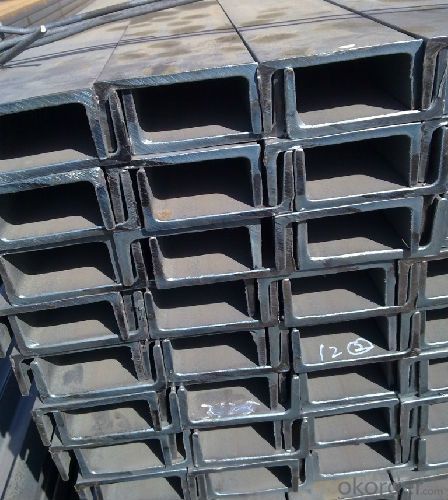
- Q: What is the maximum load-bearing capacity of channel 12M span 100?
- When flat, the span of one meter is concentrated, and the solution is as follows: M=W[,]=15610*215=3356150N-mm=3.356kN-mM=L/4*N+q*L*L/8N= (M-0.1*1*1/8), *4= (3.356-0.1*1*1/8), *4=13.374kN (1.3 tons)When standing, the span of one meter is concentrated, and the solution is as follows: M=W[,]=39660*215=8526900N-mm=8.527kN-mM=L/4*N+q*L*L/8N= (M-0.1*1*1/8), *4= (8.527-0.1*1*1/8), *4=34.058kN (3.4 tons)
- Q: How do steel channels perform under vibration?
- Steel channels generally perform well under vibration due to their high strength and stiffness. The structural integrity and durability of steel channels allow them to withstand dynamic loads and vibrations without significant deformation or failure. Steel's inherent properties, such as its high modulus of elasticity and superior damping characteristics, help to absorb and dissipate the energy generated by vibrations. Steel channels are often used in applications where vibration resistance is crucial, such as in the construction and transportation industries. They are commonly employed in the design of bridges, buildings, and industrial equipment, where they provide robust support and stability under dynamic loads and vibrations. To further enhance their performance under vibration, steel channels can be designed with additional features, such as reinforcement ribs or sandwich structures, which can increase their stiffness and damping properties. These design modifications can help to minimize the amplitude of vibrations and reduce the risk of fatigue or failure. However, it is important to note that the specific performance of steel channels under vibration can vary depending on various factors, including the design, material properties, and the magnitude and frequency of the vibrations. Proper engineering analysis and design considerations, such as selecting the appropriate steel grade and cross-sectional shape, are essential to ensure optimal performance and safety in vibration-prone environments.
- Q: How do steel channels contribute to the overall safety of a project?
- Steel channels play a crucial role in enhancing the overall safety of a project in several ways. Firstly, these structural components provide robust support and reinforcement to various structures, such as buildings, bridges, and infrastructure projects. The strength and durability of steel channels make them capable of withstanding heavy loads and extreme weather conditions, minimizing the risk of structural failure or collapse. Moreover, steel channels are fire-resistant, which is a significant advantage in terms of safety. In the event of a fire, steel channels can withstand high temperatures for an extended period, offering valuable time for evacuation and minimizing the spread of flames. This fire resistance property makes steel channels highly suitable for projects where fire safety is a critical concern, such as high-rise buildings, industrial facilities, and transportation infrastructure. Another important contribution of steel channels to project safety is their ability to resist corrosion. Steel channels are typically made from galvanized or stainless steel, which are highly resistant to rust and corrosion. This resistance ensures the structural integrity of the channels over time, reducing the risk of deterioration and potential hazards. Consequently, projects utilizing steel channels can enjoy a longer lifespan and require less maintenance, ultimately enhancing safety and reducing the need for costly repairs. Additionally, steel channels offer versatility in design and construction. They can be easily customized and fabricated to suit specific project requirements, allowing for precise and secure connections between various structural elements. This versatility ensures accurate alignment and integration of components, minimizing the chances of structural instability or compromise. Lastly, steel channels provide excellent load-bearing capacity, enabling the distribution of weight and stress evenly across a structure. This even distribution of loads prevents localized points of weakness or excessive strain, thereby enhancing the overall stability and safety of the project. In conclusion, steel channels contribute significantly to the overall safety of a project by providing robust support, fire resistance, corrosion resistance, versatility in design, and excellent load-bearing capacity. By incorporating steel channels into construction projects, the risk of structural failure, fire hazards, and deterioration can be greatly minimized, ensuring the safety and longevity of the project.
- Q: I encountered in the construction of 2 short 28# channel welding, processed into beams, how to weld? Do I have to have stiffened panels? How many pieces? What's the thickness of the stiffener? I heard that there is a book called "metal processing manual", which has instructions, but I do not have the book. Please give settlement.
- Manual arc welding and J422 (E4303) welding electrodes can be used.Take the side of the web welded stiffening plate (channel steel, in the inner side of the groove with stiffening plate), the wing plate with open groove back sealing welding, welding before welding groove groove cutting slag and its inclusion must be cleared; after welding inspection. The web stiffener is greater than or equal to the thickness of the web. The dimension of the reinforcing plate is: the length of the steel plate is equal to the height of the section steel, and the width is equal to the height of the section steel, minus 70mm.
- Q: How do steel channels resist corrosion?
- The main reason why steel channels are resistant to corrosion is because of the protective oxide layer that forms on their surface. This layer, also known as a patina, acts as a barrier between the metal and its surroundings, preventing direct contact and reducing the likelihood of corrosion. The formation of the patina occurs through a process called passivation, which happens when steel is exposed to oxygen in the air or water. Passivation assists in creating a stable and firmly attached layer of oxide that effectively inhibits the corrosion process. Additionally, steel channels can receive further protection against corrosion through different surface treatments like galvanization or coating with materials that are resistant to corrosion, such as zinc or paint. These treatments provide an additional layer of defense against moisture, chemicals, and other elements that cause corrosion. It is crucial to regularly maintain and inspect steel channels to prevent corrosion, as any damages or breaches in the oxide layer can expose the underlying metal and increase the risk of corrosion. In summary, the combination of the natural passivation process, surface treatments, and proper maintenance contribute to the high resistance of steel channels to corrosion, ensuring their durability and longevity in various applications.
- Q: Can steel channels be used in bridge construction?
- Yes, steel channels can be commonly used in bridge construction. Steel channels are structural components made of steel that have a C-shaped cross-section. They offer high strength, durability, and versatility, making them suitable for various applications in bridge construction. Steel channels are often used as beams or supports in bridge construction because of their ability to withstand heavy loads and provide structural stability. They can be used as primary load-bearing members or secondary components to support other bridge elements. The use of steel channels in bridge construction offers several advantages. Firstly, steel channels have excellent strength-to-weight ratio, meaning they can provide high load-carrying capacity while being relatively lightweight. This results in cost savings during construction and reduces the overall weight of the bridge, leading to more efficient designs. Secondly, steel channels are resistant to corrosion, which is crucial for bridges exposed to harsh environmental conditions, such as bridges built near saltwater or in areas with high humidity. Steel channels can be galvanized or coated with protective layers to enhance their resistance to corrosion, ensuring the longevity and durability of the bridge structure. Furthermore, steel channels can be easily fabricated and customized to meet specific design requirements. They can be cut, welded, and shaped into various lengths and sizes to fit the bridge design. This flexibility allows engineers to create complex bridge structures that are both strong and aesthetically pleasing. In conclusion, steel channels are a commonly used component in bridge construction due to their strength, durability, and versatility. They provide structural stability, high load-carrying capacity, resistance to corrosion, and cost-effective solutions for bridge designs.
- Q: Can steel channels be used for signpost installations?
- Yes, steel channels can be used for signpost installations. Steel channels are commonly used in construction and engineering projects due to their strength, durability, and versatility. They provide a sturdy support structure for various applications, including signpost installations. Steel channels are capable of withstanding environmental factors such as wind, rain, and temperature changes, making them suitable for outdoor use. Additionally, their rigidity ensures that the signpost remains stable and secure. Overall, steel channels are an excellent choice for signpost installations, offering long-lasting support and reliability.
- Q: How are steel channels resistant to corrosion?
- Due to the presence of a protective oxide layer on their surface, steel channels exhibit resistance to corrosion. This oxide layer is naturally formed through a process known as passivation, wherein exposure to oxygen in the air results in the creation of a thin layer of chromium oxide on the steel's surface. Acting as a barrier, this oxide layer effectively hinders the contact between oxygen, moisture, and the underlying steel, thus inhibiting the corrosion process. Moreover, the corrosion resistance of steel channels can be further improved by applying various coatings and treatments such as galvanization or painting. These measures offer an extra layer of protection against corrosive elements, thereby enhancing the overall resistance of steel channels to corrosion.
- Q: How do steel channels perform under live loads?
- Steel channels, commonly used in construction projects, are known for their durability and reliability. They excel in supporting heavy loads and distributing them evenly along their length, making them suitable for applications with live loads, like people or equipment. The design of steel channels efficiently resists bending and buckling, ensuring the integrity and stability of the structure. Their shape and cross-section provide a high moment of inertia, contributing to their superior load-carrying capacity. This means they can withstand larger live loads without excessive deflection or deformation. In addition, steel channels offer a high strength-to-weight ratio, making them ideal for structures that require significant load-bearing capacity while minimizing weight. This advantage is particularly valuable in applications like bridges or overhead cranes, where the weight of the structure needs to be minimized. Furthermore, steel channels are highly resistant to fatigue, allowing them to endure repeated loading and unloading without significant loss in performance. This characteristic makes them well-suited for applications involving dynamic loads, such as moving vehicles or heavy machinery. To summarize, steel channels perform exceptionally well under live loads. They support heavy loads, distribute them evenly, resist bending and buckling, and withstand repeated loading. These qualities make steel channels a reliable and efficient choice for various construction projects that require superior load-bearing capacity and structural stability.
- Q: Can steel channels be used for racking systems?
- Indeed, racking systems can utilize steel channels. These channels offer a robust and long-lasting solution for storing hefty loads. Typically, they are crafted in a C-shape which facilitates easy installation and provides a sturdy support structure for the racking system. Steel channels can be employed in various types of racking systems, including pallet racks, cantilever racks, and mezzanine racks. They possess exceptional load-bearing capabilities and can endure the weight and pressure exerted by the stored items. Additionally, steel channels exhibit resistance to corrosion, rendering them suitable for both indoor and outdoor racking systems. All in all, steel channels are a dependable and adaptable option for constructing efficient and secure racking systems.
Send your message to us
UPN JIS U Channel JIS SS400 or GB Q235 Q345B for all Sizes
- Loading Port:
- China Main Port
- Payment Terms:
- TT or LC
- Min Order Qty:
- -
- Supply Capability:
- -
OKorder Service Pledge
OKorder Financial Service
Similar products
Hot products
Hot Searches
Related keywords
